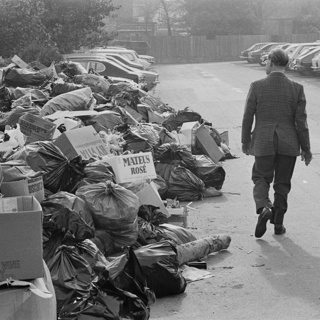
175. Liberals transformed and struggling for social reform
The tragedy that struck Joseph Chamberlain in 1906, a massive stroke that paralysed his right side and left this outstanding orator barely capable of speaking, allowed ex-Prime Minister Arthur Balfour to confirm his leadership of the opposition to the Liberal government and of the Unionists in the Commons. He and Lord Lansdowne, in the Lords where the Unionists enjoyed a huge majority, worked hard together to frustrate Liberal legislative proposals. They did, however, let through the Old Age Pensions Act, at least in part because they accepted the government argument that it was a ‘money bill’, a financial measure, and by convention such bills were initiated in the Commons and accepted unamended by the Lords. It came into effect in 1908 and represented a turning point. It was the first step towards the welfare state, and it marked the point when the Liberal Party abandoned classical Liberalism, focused on curbing government spending and avoiding interventions into what were called ‘condition of the people’ matters. New Liberalism took steps to alleviate poverty and was prepared to accept the increased government expenditure that this entailed. Illustration: Amedee Forestier, Pension Day Pensioners Collecting their Old Age Pension, 1909, public domain image made available by WikiGallery.org Music: Bach Partita #2c by J Bu licensed under an Attribution-NonCommercial-No Derivatives (aka Music Sharing) 3.0 International License.
31 Dec 202314min

174. Men disappointing women
The first couple of years of the Liberal government elected in 1906 saw some achievements but also a great deal of frustration. The Unionist majority in the House of Lords annulled the Liberals’ in the Commons. That blocked many of the government’s initiatives. This period ended in August 1907 when Campbell-Bannerman, the Prime Minister, started a series of three heart attacks over the next fifteen months. Ultimately, they left him bedbound until, in April 1908, he became the only Prime Minister to die in 10 Downing Street. Meanwhile, in the women’s movement, and in particular among the Suffragists of Millicent Fawcett’s National Union of Women’s Suffrage Societies, the NUWSS, dominated by Liberals, there had been great hopes of seeing progress with a Liberal government in power. They were dashed by Campbell-Bannerman’s refusal to act. In part, this was down to party considerations, since both organisations were looking not for universal adult suffrage, but only equality of voting rights with men, on the existing basis. That would only enfranchise relatively well-off women, and they would be inclined to vote Conservative. Just as the NUWSS was linked to the Liberals, so the other main organisation, Emmeline Pankhurst’s Women’s Social and Political Union (WSPU) was closely bound to Labour. However, the Pankhursts – both Emmeline and her daughter and closest collaborator Christabel – began to lose faith in Labour from the very time they set up the WSPU. They favoured more militant action, such as intervening in public meetings and heckling speakers. The effectiveness of their campaigning in gaining publicity for the movement even persuaded Fawcett took move towards direct methods, for instance in organising the 3000-strong ‘Mud March’ in 1907. But when HH Asquith, an opponent of women’s suffrage, took over as Prime Minister from Campbell-Bannerman, and it became clear that the government wasn’t going to advance the women’s cause anytime soon, the two organisations’ ways began to part. The SWPU began to explore far more militant tactics yet, which the NUWSS wouldn’t be prepared to adopt. That, though, is for later episodes… Illustration: Christabel Pankhurst, by Ethel Wright, in a portrait exhibited in 1909 National Portrait Gallery 6921 Music: Bach Partita #2c by J Bu licensed under an Attribution-NonCommercial-No Derivatives (aka Music Sharing) 3.0 International License.
24 Dec 202314min

173. Liberal progress slowed. And another suffragist first
The 1906 general election had given the Liberals a colossal majority in the House of Commons. In the Lords, however, the Unionist opposition still held an unassailable majority against them. This meant that they could block Liberal legislation as they wished. Some significant measures were lost as a result. On the other hand, some passed, including, strangely enough, some measures backing working-class rights, hardly the kind of initiative you’d expect Conservatives to back. However, they have felt they could win votes that way, as a higher number of working-class voters seemed to support them than might have been expected, and the Conservatives might well be able to take advantage of the fact that in some cases, there were even internal divisions within the Liberals on such issues. Meanwhile, the new Liberal, and newly appointed Under Secretary for the Colonies, Winston Churchill, agreed with the former Boer general Jan Smuts steps towards giving the Boers equal rights with the British in South Africa. Black South Africans were denied any say in their government. It’s clear that possession of a white skin was a route to privilege even under British rule and long before apartheid. Finally, the suffragists, as opposed to the more militant suffragettes, gained another success in a new breakthrough achieved by England’s first female doctor, Elizabeth Garrett Anderson, when she became England’s first femal town mayor. Illustration: In 1901, during hte Boer War: surrounded by other Boer guerrillas, General Jan Smuts, once Churchill’s captor, later his lifelong friend. Public domain. Music: Bach Partita #2c by J Bu licensed under an Attribution-NonCommercial-No Derivatives (aka Music Sharing) 3.0 International License.
17 Dec 202314min

172. Liberals back, great power tensions too
Arthur Balfour’s intention in resigning as Prime Minister but without a general election was probably to oblige Liberal leader Henry Campbell-Bannerman to form a government, which might force their divisions to the surface. That would weaken their chances in an election that was bound to be held soon. There was a curious symmetry between the divisions in the main parties. The Liberals were split three ways over the Boer War. Liberal Imperialist right wing backed Britain’s military intervention, while the left, sometimes called pro-Boer, opposed it, and in the middle a group around the leader accepted the need for war but denounced its most brutal aspects (such as the concentration camps). Meanwhile, the Unionists were split three ways over tariff reform. The ‘wholehoggers’ backed a full system of import tariffs to protect British trade, the free traders wanted to stick with the old doctrine of tariff-free commerce, and a group around the leader accepted the need for reform but wanted to proceed more cautiously. Unfortunately, tariff reform was topical while the war had been over for three years. The Liberals were able to unite in attacking the government, specifically over tariff reform. And they won their last landslide in the 1906 election. Despite the end of the Boer War, the new Liberal government faced a world haunted by the spectre of renewed war. There was uncertainty over who the enemy would be if a new war broke out. The traditional enemy was France, and Britain likes its traditions. But an increasing threat was now coming from across the North Sea in Germany. Politicians and even novelists (the latter best represented by Erskine Childers and his Riddle of the Sands) were beginning to warn that the German threat was the more serious. The entente cordiale with France in 1904 showed Britain beginning to move closer to France and further away from Germany. Then Kaiser Wilhelm II of Germany showed up in Tangier in Morocco, making a speech designed to provoke France, and tensions quickly grew. The conference that ended the crisis failed to address Germany’s issues. That made Tangier just the first of a series of crises that set two groupings of European great powers increasingly at odds with each other. Finally, this episode also talks about a small step forward in the ugliest of the European colonies in Africa, Congo. Again with a link to a novel. Illustration: A 1904 British cartoon on the Entente cordiale: John Bull (Britain) walking off arm-in-arm with Marianne (France), turning their back on Wilhelm II of Germany, whose sabre is poking out of his coat. A Punch cartoon by John Bernard Partridge. Music: Bach Partita #2c by J Bu licensed under an Attribution-NonCommercial-No Derivatives (aka Music Sharing) 3.0 International License.
10 Dec 202314min

171. Tories on the rocks
The divisions among Unionists – the Conservative Party and the Liberal Unionists, then in government together – over tariff reform massively damaged their electoral chances and came as a real gift to the Liberals. That was on top of Balfour’s Education Act of 1902, which had allowed the Liberals to heal their rifts over the Boer War and come together in attacking the government. It looked as though the Unionists were heading for a drubbing at the polls in the next general election. But the Liberals weren’t complacent. One of the things they did was come to an agreement with the new Labour Representation Committee led by Keir Hardie, now with four MPs, not to stand a Liberal candidate against theirs in constituencies where they had a real chance of beating the Tory. This may have been a smart move by the Liberals, maximising Tory losses at the subsequent general election. Then again, it may have been a terrible self-inflicted wound, letting in a party that would soon eclipse them as the main party of opposition to the Tories. When the election came, it was a disaster for the Conservatives and a tremendous win for the Liberals, which took 397 seats in a House of Commons f 670. Labour too surged, wining 29 seats, 24 of them in constituencies covered by the agreement with the Liberals. The Liberal majority meant that the doors had opened for the leader Henry Campbell-Bannerman to make some real changes in Britain. Sadly for the Liberals, however, though they didn’t yet know it, they had just had their last landslide election win and would soon have their last elections wins of any kind. They were also starting on their last term in government on their own, rather than part of a coalition. They might be celebrating the present, but the future would turn out much bleaker. Illustration: Sir Henry Campbell-Bannerman, Liberal leader who led the Liberals into their election landslide in 1906. The picture is from 1907, by London Stereoscopic & Photographic Company, National Portrait Gallery P1700(86b) Music: Bach Partita #2c by J Bu licensed under an Attribution-NonCommercial-No Derivatives (aka Music Sharing) 3.0 International License.
3 Dec 202314min

170 Unionism: the gathering storm
A factor of small but growing importance at the end of Salisbury’s premierships, and during Balfour’s that followed, was offered by the Labour Representation Committee. It had been formed by trades unions working with left-wing parties of the working class, most notably Keir Hardie’s Independent Labour Party. With no MPs before the election of 1900, it had grown to four by 1903 which, in an environment in which third parties have trouble establishing themselves, was a substantial development. Meanwhile, the ruling Unionists were beginning to divide against each other. The question that finally split them was Tariff reform, the same issue that had split them back in 1846 when Robert Peel repealed the corn laws to usher in a long period of free trade without tariffs, but in the opposite direction: the tariff reformers at the start of the twentieth century, led by Joseph Chamberlain, wanted to reintroduce tariffs. The aim was both to create barriers protecting British industry and agriculture (even if that meant increasing the price of food, painful above all for the poor), and to allow for imperial preference, the system which would draw the colonies closer to the mother country by exempting their economies from certain tariffs. Three factions emerged within the Unionist coalition, right up to cabinet level. One, led by the Chancellor of the Exchequer, remained wedded to free trade. A second, the Prime Minister’s, was sympathetic but wanted to proceed slowly. The third, Chamberlain’s, was for rapid introduction of tariffs and imperial preference. Split parties don’t win elections, and now the Unionists were hopelessly split. With an election looming. Illustration: Some of the white, male attendees at the 1902 Colonial Conference. Joseph Chamberlain is in the middle of the front row, with Wilfrid Laurier,Prime Minister of Canada to his right (our left). Music: Bach Partita #2c by J Bu licensed under an Attribution-NonCommercial-No Derivatives (aka Music Sharing) 3.0 International License.
26 Nov 202314min

169. Anti-Immigrant? Or just anti-Semitic?
A major issue the Balfour government had to deal with was immigration. That became a thinly veiled pretext for anti-Semitism, since increased persecution of Jews inside the Russian empire sent huge numbers abroad seeking for refuge. A great many reached London, though far fewer than was often claimed. This episode looks at the reactions to the problem, which was often surprising, at least in appearance. Some Jewish leaders backed measures to restrict immigration. So, at one time, did the kind of figure you would imagine to be more sympathetic to people fleeing persecution, such as Keir Hardie in the forerunner of the Labour Party, though he and his colleagues later came down firmly against anti-immigration measures. Many of the backers, though, were the usual suspects. Some were genuinely convinced that what they were seeking was restriction on destitute and undesirable immigrants. Many others, however, felt that what was really being sought was an anti-Semitic measure to keep Jews out of Britain. Illustration: Sir William Evans-Gordon, cartoon by ‘Spy’, from ‘Vanity Fair’, 11 May 1905 National Portrait Gallery D45274 Music: Bach Partita #2c by J Bu licensed under an Attribution-NonCommercial-No Derivatives (aka Music Sharing) 3.0 International License.
19 Nov 202314min

168. Balfour's bad luck
Poor Balfour. He achieved a surprising amount considering how little time he had as head of government. What made it worse was that most of the measures he pushed through attracted at least as much criticism as praise. Often they caused deepening rifts amongst his own Unionists and even, on at least one occasion, strengthened the Liberals by helping to unite them again after their own deep splits on the Boer War. At least he did manage to get an Entente Cordiale with the French, ratcheting way, way down the traditional tensions between Britain and its neighbour across the Channel. On top of that, he had to deal with an old friend, George Curzon, who as viceroy of India found himself, like other colonial governors, unable to resist the temptation to launch a military adventure. The expedition into Tibet cost lives, though mostly among the poorly armed Tibetans, cut down by the superior British weapons, and in the end achieved virtually nothing. Which was entirely emblematic of Balfour's time in the top job. Illustration: Detail of John Singer Sargent’s portrait of Balfour in 1908. National Portrait Gallery 6620 Music: Bach Partita #2c by J Bu licensed under an Attribution-NonCommercial-No Derivatives (aka Music Sharing) 3.0 International License.
12 Nov 202314min





















